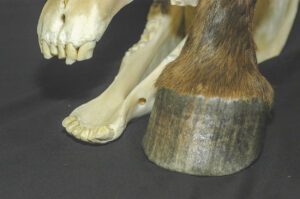Keeping Performance Horses Sound, AAEP 2008
James Gilchrist, Certified Farrier, of the Palm Beach Farriery Service in Florida, offered several strategies he finds useful for his high-performance clients during the "Putting Science into Farriery" session at the 2008 Convention of the American Association of Equine Practitioners. "Not a day goes by that I don’t talk to a veterinarian about a half-dozen of these horses," he said. "A team approach is very important to the health of these horses."
He noted that evaluating what trimming/shoeing these horses need requires a combination of gait evaluation; hoof tester examination; discussion of the horse’s history with the owner, trainer, and veterinarian; and evaluation of the wear patterns of the old shoes. Proper trimming is key, he said: "It doesn’t matter how good the shoe is if the foot isn’t trimmed right."
Once the trim is right, the farrier must select right shoe. Gilchrist likes a perimeter-fit shoe (i.e., not one that is squared and doesn’t go out to the edge of the wall) with toe clips, a wide web, and a rolled toe for most horses, and he finds that grinding down square shoe edges all the way around helps promote easier breakover in all directions. Half-round shoes are also useful for this; he noted that they might absorb some shock as the shoe settles into soft ground, which is good for sore-footed horses
Create a free account with TheHorse.com to view this content.
TheHorse.com is home to thousands of free articles about horse health care. In order to access some of our exclusive free content, you must be signed into TheHorse.com.
Start your free account today!
Already have an account?
and continue reading.
Related Articles
Stay on top of the most recent Horse Health news with

















